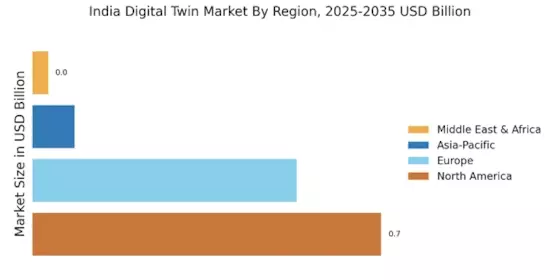Growing Focus on Sustainability
The India Digital Twin Market is increasingly aligned with sustainability goals as organizations seek to minimize their environmental impact. Digital twins enable companies to analyze resource consumption and optimize processes, leading to reduced waste and energy usage. Industries such as energy, transportation, and manufacturing are leveraging digital twin technologies to enhance their sustainability efforts. For example, by simulating energy consumption patterns, companies can identify opportunities for efficiency improvements. The emphasis on sustainable practices is likely to drive the adoption of digital twins, as businesses aim to meet regulatory requirements and consumer expectations for environmentally friendly operations. This trend suggests a promising future for the digital twin market, as sustainability becomes a key driver of innovation.
Enhanced Simulation Capabilities
The India Digital Twin Market is witnessing advancements in simulation technologies that enable more accurate modeling of physical assets. These enhanced simulation capabilities allow organizations to create detailed digital representations of their products and processes, facilitating better decision-making. Industries such as aerospace, automotive, and manufacturing are increasingly utilizing digital twins to simulate various scenarios, thereby optimizing design and production processes. The ability to conduct virtual testing and validation is expected to drive the adoption of digital twin solutions, as companies aim to reduce time-to-market and improve product quality. As a result, the market for simulation-driven digital twins is anticipated to expand significantly, reflecting the growing need for innovation and efficiency in product development.
Government Initiatives and Support
The India Digital Twin Market is benefiting from various government initiatives aimed at promoting digital transformation across sectors. The Indian government has launched several programs to encourage the adoption of advanced technologies, including digital twins, in manufacturing, urban planning, and infrastructure development. For instance, initiatives like 'Make in India' and 'Digital India' are designed to foster innovation and enhance competitiveness. These programs are likely to provide financial incentives and support for businesses looking to implement digital twin technologies. As a result, the market is expected to gain momentum, with increased investments in digital infrastructure and smart city projects. This supportive regulatory environment is crucial for the growth of the digital twin ecosystem in India.
Integration with Advanced Technologies
The India Digital Twin Market is poised for growth due to the integration of digital twins with advanced technologies such as artificial intelligence (AI) and the Internet of Things (IoT). This convergence allows for real-time data collection and analysis, enhancing the functionality of digital twins. Industries are increasingly adopting these integrated solutions to improve operational efficiency and decision-making processes. For instance, the combination of IoT sensors with digital twins enables continuous monitoring of assets, leading to timely interventions and optimized performance. The market for IoT-enabled digital twins is expected to expand rapidly, as organizations recognize the potential for increased automation and data-driven insights. This integration is likely to be a pivotal factor in the evolution of the digital twin landscape in India.
Rising Demand for Predictive Maintenance
The India Digital Twin Market is experiencing a surge in demand for predictive maintenance solutions. Industries are increasingly recognizing the value of digital twins in anticipating equipment failures and optimizing maintenance schedules. This proactive approach not only reduces downtime but also enhances operational efficiency. According to recent estimates, the predictive maintenance market in India is projected to grow at a compound annual growth rate (CAGR) of over 25% in the coming years. This trend indicates a strong inclination towards adopting digital twin technologies, as organizations seek to leverage data analytics and real-time monitoring to improve asset management. Consequently, the integration of digital twins into maintenance strategies is likely to become a cornerstone for industries aiming to enhance productivity and reduce operational costs.


















Leave a Comment